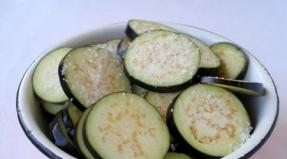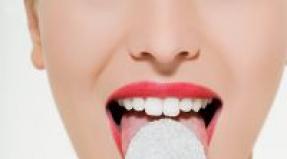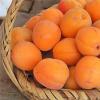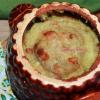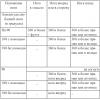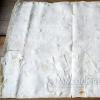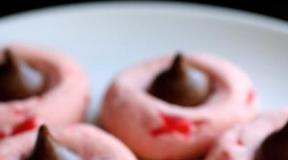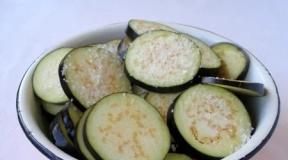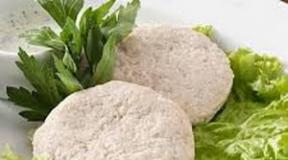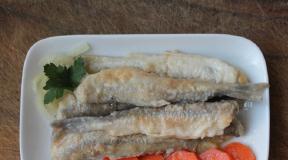Homemade squash caviar calorie content per 100 grams. How many calories are in squash caviar? Nutritious snack recipe for every day
Squash caviar is deservedly considered a dietary product. It is recommended for baby food, and for people with various diseases, and for those who want to lose excess weight. This comes as no surprise considering how many calories are in this popular snack and how healthy it is.
Composition and energy value

Zucchini is known as a very low-calorie product, containing only 24-25 kcal per 100 g. In addition, they contain an impressive range of nutrients - vitamins and minerals.
When preparing squash caviar, in addition to squash, you use:
- carrot;
- tomatoes;
- vegetable oil;
- spices;
- garlic, vinegar, herbs - optional.
If the calorie content of zucchini, onions, carrots, and tomatoes is low, then vegetable oil has an energy value of about 900 kcal. Therefore, how many calories are in zucchini caviar depends on the recipe and method of preparation.
The snack that is offered in stores is usually prepared according to classic recipes; its calorie content is indicated on the can and ranges, as a rule, from 75 to 100 kcal per 100 g. The composition of such a product is stewed or fried vegetables, spices and vegetable oil. The energy value is directly related to how much vegetable oil is used during cooking. The color can tell a lot - the lighter the zucchini caviar, the less calorie it contains (this means that the vegetables were stewed, not fried, and there is less oil).
As a rule, 100 g of squash caviar contains:
- proteins: 1-2 g;
- fats: 6-8 g;
- carbohydrates: 7-9 g.
Also, squash caviar contains dietary fiber, water, organic acids, ash, unsaturated fatty acids, etc.
The benefits of squash caviar

The product has a rich, balanced composition, represented by a vitamin and mineral complex:
- vitamins: A, C, E, PP, H, group B;
- macroelements: calcium, potassium, magnesium, sodium, sulfur, chlorine, phosphorus;
- trace elements: iron, manganese, iodine, copper, zinc, fluorine, aluminum, boron, etc.
This composition, with its low calorie content (and excellent taste of the product), makes caviar very healthy. Benefit:
- improves digestion due to its fiber content;
- antioxidants prevent cell aging;
- increases immunity;
- removes harmful substances from the body;
- strengthens the cardiovascular system.
How much squash caviar can you eat to benefit your body? Nutritionists believe that a person can consume 100-150 g of this product daily without fear. Unfortunately, there are categories of people who should be careful:
- with peptic ulcer and gastritis;
- with urolithiasis.
Caution is also necessary when purchasing squash caviar in a store. Pay attention to the expiration date, the appearance of the jar, and the absence of preservatives. Buy a fresh and, preferably, prepared according to GOST, product. You should also not forget that the calorie content of store-bought caviar is about 100 kcal, so know when to stop.
How to reduce calories?

Squash caviar is a famous dish that has been popular for several decades. This product is one of the most valuable in nutrition, as it contains many useful substances. In addition, caviar from zucchini is often included in the diet menu and becomes the basis of proper nutrition, since it has low calorie content.
A tasty, light, healthy dish, and also low in calories - what could be better? All this can be said about squash caviar. There are many recipes for its preparation, so everyone can choose the best option for themselves.
Traditionally, caviar includes: carrots, zucchini themselves, and tomatoes. Why has this fairly simple dish not lost its popularity for a long time?
The benefits of squash caviar
First of all, this product is well absorbed by the body, which is why it is often recommended by nutritionists. Zucchini caviar contains nutrients and microelements that are important for the proper functioning of the body. They normalize the functioning of all organs and systems, strengthen the immune system, improve blood condition, and promote the restoration of cells and metabolic processes in the body.
Nutritional value and composition
This product contains the following microelements and vitamins:
| Microelement | Benefit |
|---|---|
| Potassium |
|
| Magnesium | necessary for the normal functioning of the circulatory system. |
| Iodine |
|
| Calcium |
|
| Copper |
|
| Zinc |
|
| Phosphorus |
|
| Manganese |
|
| Fluorine |
|
| Pectins |
|
| Folates (folic acid compounds) |
|
| Lycopene (antioxidant) |
|
| Beta-carotene (antioxidant) |
|
| Vitamin C |
|
| Vitamin A |
|
| B vitamins | Necessary for the normal functioning of the cardiovascular and nervous systems, help eliminate intestinal problems, improve skin condition, and are important for the body’s metabolism. |
| Vitamin PP |
|
| Vitamin E |
|
| Vitamin H |
|
The value of the product lies in the fact that caviar is low in calories and is allowed even on a diet. On average, 100 g of product contains:
The table shows that the nutritional value of different types of caviar is slightly different.
The calorie content of the finished dish is 90 kcal. This indicator is average and may vary depending on the products included in the caviar: tomatoes, peppers, mayonnaise, spices, type of zucchini.
The most popular types of squash caviar are:
Can you lose weight with snacks?
According to experts, it is possible to lose weight by eating squash caviar. And the variety of types allows you to choose a dish for every taste.
Zucchini contains a lot of water, fiber, vitamins, microelements, and mineral salts. Thanks to this composition, this vegetable is ideal for dietary nutrition and is effective for digestive problems, problems with the gastrointestinal tract and liver. Zucchini can be added to salads, stewed, boiled. bake.
When creating a dietary menu, you can use many recipes for preparing squash caviar, which will allow you to diversify your diet. On average, the duration of a diet based on this dish is 5-7 days. In addition to squash caviar, you should definitely consume other products:
- low fat cottage cheese;
- boiled or baked chicken meat;
- cereals (buckwheat, barley);
- fruits;
- potatoes (boiled and in small quantities);
- tea based on medicinal herbs.
To choose the optimal diet with caviar, you need to contact a nutritionist who will create a diet taking into account the individual characteristics of the body and possible problems with the digestive system.
How to choose vegetables for cooking caviar
To make caviar tasty, juicy, rich, you need to choose the right ingredients, first of all the main one - zucchini.
Vegetables should be:
- fresh;
- young;
- small (length - 20-25 cm, weight - about 300 g).
It is better to choose zucchini such that there are no seeds in the core (or the seeds should be very soft, small, so that they can easily be twisted through a meat grinder or ground in a blender), then the caviar will turn out tender, without lumps. The vegetable should have a soft skin (it can be easily “scratched” with your finger).
If you take overripe fruits with hard skin and seeds for cooking, then you just need to peel the vegetable and remove the core.
Not only the appearance of the fruit is important, but also the time of purchase. It is advisable to choose a vegetable in July-September, when the zucchini is ripe and contains a minimum of chemical additives.
Cooking recipes
There are many recipes for making caviar from zucchini. They are quite simple and do not take much time.
Preparation with tomato paste
Ingredients:
- zucchini - 5 kg;
- tomato paste - 400 g;
- garlic - 4 cloves;
- salt - 3 tbsp;
- vinegar - 8 tbsp;
- butter - 100 g;
- granulated sugar - 150-200 g.
Peel the zucchini, chop and mince. Add all ingredients except garlic and vinegar. Stir and cook over medium heat for 50 minutes. Finally, add the remaining ingredients and cook for another 15 minutes. Divide into jars. 
Recipe without rolling
You don’t need to seal this dish in jars, but put it in the refrigerator. You will need:
- zucchini - 2 pcs.;
- tomatoes - 3 pcs.;
- onion - 1 pc.;
- oil - 4 tbsp;
- garlic - 5 cloves;
- sweet pepper - 1 pc.;
- salt and pepper to taste.
Pour oil into a saucepan or cauldron and fry finely chopped onion until golden brown. Add peeled chopped pepper and simmer for 5-7 minutes. Peel the tomatoes (this is done very easily: you need to pour boiling water over the tomatoes) and place in a dish.
Lastly, add the chopped zucchini. Cover the pan with a lid and simmer for 1 hour. Before finishing cooking, add pepper, salt, garlic and stir. Let it brew for several hours (you can put it in the refrigerator). 
Preparing for the winter with apples
Zucchini caviar with apples and peppers is very tasty and original. For preparation you will need:
- zucchini and tomatoes - 3 kg;
- carrots - 2 kg;
- onion - 1 kg;
- garlic - 1 head;
- sweet and sour apples - 4 pcs.;
- sweet pepper - 5 pcs.;
- hot pepper to taste - 1/2 or 1 pc.;
- butter - 50 g;
- sugar and salt to taste.
All vegetables and fruits need to be washed well, peeled, cut, and minced. Place vegetables and fruits in a saucepan, add oil, cook over low heat for 3 hours. The result should be a medium-thick dish. Add remaining ingredients. Mix everything thoroughly and place in sterile jars. 
Squash caviar with mushrooms
Another interesting recipe is caviar with champignons. It requires:
- zucchini - 1 kg;
- mushrooms - 500 g;
- tomatoes - 6 pcs.;
- onions - 3 pcs.;
- carrots - 1 pc.;
- garlic to taste - 2-4 cloves;
- bell pepper - 1 pc.;
- tomato sauce - 1-3 tbsp;
- sugar - 20 g;
- hot red pepper - on the tip of a teaspoon;
- vegetable oil - 100 g;
- salt and pepper to taste.
Peel all vegetables. Cut tomatoes, zucchini and mushrooms into small cubes, onions into half rings or cubes, grate carrots. Pour oil into the pan and fry the mushrooms for 15 minutes, then transfer them to a plate.
Next, fry the carrots and onions (20 minutes), add zucchini, seasonings, sweet peppers, and tomatoes. Close the lid and simmer for 45-60 minutes. About halfway through cooking, add the fried champignons and tomato sauce to the pan. If necessary, add more seasonings, garlic, lemon juice, and, if desired, finely chopped dill (parsley). Leave the caviar to simmer under the lid for 30 minutes.
The last step is to pour into jars and leave until completely cool.
Squash caviar is healthy, tasty, and easy to prepare. It is considered a dietary product and is recommended for people who are overweight and have problems with the digestive tract. Zucchini, and therefore squash caviar, contain a huge amount of vitamins, microelements, and minerals that are of great importance for the normal functioning of almost all organs and systems.
Video recipe for squash and mushroom caviar:
The most common types of squash caviar are: homemade, store-bought, with butter or mayonnaise. Thanks to the availability of many recipes, choosing and preparing a tasty and low-calorie dish is not difficult.
In contact with
The end of summer is rich in various vegetables, in particular zucchini. They are fried, canned, salted, stuffed with meat and vegetables, and also added to various dishes. But one of the most favorite dishes remains squash caviar.
Traditional Russian dish
Few people know that squash caviar is a truly Russian dish. It began to be produced in 1930, but three years later production was banned due to an outbreak of botulism, which, for unclear reasons, was blamed on caviar. Several decades later, the dish was rehabilitated, but quality control began to be strictly monitored.
The condition of the jar must be carefully assessed even when purchasing in a store: the lid is swollen - the product must be thrown away. Otherwise, poisoning may occur. If you prepare caviar at home, then remember an important tip: before closing, you need to thoroughly sterilize it at a temperature of 120 degrees, because the product has very low acidity.
Nutritional value of the product
According to GOST, the composition of squash caviar includes carrots, zucchini themselves, bell peppers, onions, vegetable oil, tomato paste, seasonings, granulated sugar and salt. This recipe is really just a starting point. Then housewives and cooks “conjure” the composition and create their favorite variations. Therefore, the composition of BJU differs from different recipes (data per 100 grams):
- Squash caviar with chili in a slow cooker - 0.7/2.0/5.1 g
- Dish with garlic without adding oil - 0.9/0.3/5.74 g
- Homemade variation with garlic, chili and oil - 0.9/5.6/5.3 g
- “Mother-in-law’s tongue” - 0.8/6.4/9.2 g
- Stewed squash caviar with sour cream - 1.29/3.28/5.12 g
- Indicators of canned TM “Uncle Vanya” - 1.0/7.0/7.0 g
- Caviar with mayonnaise and chicken seasoning “Mivina” - 1.1/6.7/7.9 g
Calories in squash caviar
Depending on the composition, the calorie content of squash caviar also changes. Here are the indicators of some options per 100 grams of finished dish:
- Caviar cooked in a slow cooker with the addition of chili - 40.7 kcal.
- Recipe without oil - 28.3 calories.
- Homemade caviar - 74.7 units.
- Mother-in-law's tongue recipe - 95.9 kcal.
- Caviar with sour cream - 53.16 calories.
- The nutritional value of store-bought “Uncle Vanya” is 97.0.
- With mayonnaise - 95.1 kcal.
Although squash caviar is very tasty, it cannot be called dietary. Zucchini itself is considered low-calorie and has a low glycemic index, which makes it possible to include it in a calorie-restricted diet.
During the preparation process, vegetable oil is added to the vegetables, and in quite large quantities, which increases the final energy value. So when dieting, the product should be consumed with extreme caution.
Zucchini is one of the most common and affordable vegetable crops. Therefore, it is quite common in the diet of many people in different forms. His can be subjected to various heat treatments and receive many varied and appetizing dishes, sometimes even unexpected. For those who like originality and novelty of gastronomic sensations, It would be interesting to try zucchini jam.
Zucchini is often canned to be served with a side dish or meat dishes in winter. For example, squash caviar is not only a wonderful addition to low-fat dishes, but also a source of many beneficial substances.
100 g of squash caviar contains from 80 to 100 kcal.
The calorie content of squash caviar will depend on the recipe, of which there are many varieties. Whatever the energy value, this dish has a beneficial effect on the body.
The benefits of squash caviar
The properties that squash caviar has on the human body are quite significant:
- Due to the pectin content in it, it removes harmful substances and cholesterol from the body.
- Normalizes intestinal motility due to the fact that it contains fiber.
- Prevents constipation and improves metabolism.
- Useful for diabetes.
- Fights the formation of cellulite.
- Used as a preventive measure for iron deficiency anemia.
- Improves blood quality and the condition of blood vessels.
- Nourishes the heart muscle.
Zucchini caviar can be consumed during a diet, but before starting a diet with its use, you should consult your doctor: it is not beneficial for everyone.

Squash caviar with mayonnaise
There are a great many recipes for preparing squash caviar for the winter. The most commonly used option is to preserve caviar with the addition of mayonnaise.
The calorie content of 100 g of squash caviar with mayonnaise reaches 200 kcal.
Let's consider dietary recipe for this dish. For it you will need:
- zucchini 1200 g;
- onions 200 g;
- mayonnaise with a small percentage of fat content 100 g;
- sunflower oil 50 g;
- sugar 50 g;
- salt 10 g;
- tomato paste 100 g.
Cook zucchini and onions twisted through a meat grinder for 60 minutes, add seasonings, tomato paste, mayonnaise, sunflower oil and cook for another 60 minutes. After this, pour into sterilized jars and roll up.
The energy value of caviar prepared according to this recipe is 140 kcal per 100 g of product.
Selection of zucchini for cooking caviar
In order for the quality of squash caviar to be at the highest level, it is necessary to correctly select the main ingredient for its preparation - zucchini. To do this, you can use the following recommendations:
- The outer covering of the vegetable should be shiny and smooth.
- The zucchini should be free of dents, deformed areas and spots of rot.
- Relatively small vegetables are better suited for canning because they have a low seed content and the pulp is tender.
- If you have to preserve large specimens, you need to peel them and remove the seeds.
- It is better not to take zucchini with a dried stalk.
- You should buy vegetables to prepare for the winter from the beginning of August to mid-September.
- To prevent the caviar from burning during the cooking process, it is better to cook it in a cast iron pan or in a stainless steel bowl.

Diets using zucchini caviar
The squash caviar diet involves eating caviar made by stewing zucchini, tomatoes, carrots, garlic and onions in the oven. There are many varieties. Whatever the energy value, this dish has a beneficial effect on the body.
After this, the vegetables are ground in a blender and placed in a bowl over low heat until the vegetable mass thickens.
The duration of the squash caviar diet is on average 7 days:
- For breakfast, you can eat cottage cheese and other fermented milk products along with zucchini caviar.
- For lunch, boiled chicken breast or baked fish along with caviar are good.
- For dinner you are allowed to eat buckwheat porridge or boiled potatoes, but they must be eaten together with squash caviar.
- During this diet, you can drink herbal or green tea without sugar.
- You can also eat vegetables or fruits with a small amount of sugar for all seven days.
Here's another one in diet option with squash caviar e:
- One day for breakfast, eat zucchini in the form of a casserole; for the next meal, prepare a vegetable salad with zucchini, seasoned with yogurt. For lunch you can eat vegetable soup; for the next meal, a salad with zucchini, cottage cheese and herbs is suitable. For dinner you need zucchini stuffed with vegetables.
- For breakfast the next day you need to prepare zucchini pancakes, for the second breakfast - a vegetable salad with added herbs, seasoned with sunflower oil. For lunch you need to bake fish with zucchini and carrots in foil. For an afternoon snack, simmer chopped zucchini, carrots, onions and bell peppers, chop using a blender and mix with cottage cheese. For dinner, fry mushrooms with zucchini, and also add green onions, parsley, dill or other herbs.
Change the menu for the next days one by one and drink at least 1.5 liters of water or green tea every day.

Here approximate diet of another diet on caviar from zucchini, lasting a week:
- For breakfast, zucchini casserole, a coffee drink (tea or juice), for lunch you can eat vegetable soup with zucchini and boiled chicken, as well as zucchini caviar and fruit or vegetable juice. For dinner you need to prepare stuffed zucchini, wash it down with kefir or yogurt with a small percentage of fat.
- First meal: zucchini pancakes and rosehip decoction. For lunch, baked fish with zucchini, washed down with water. In the evening, stew the zucchini with mushrooms and drink kefir.
- The next day should start with a vegetable salad and rosehip drink. During the day, eat soup with mushrooms and zucchini, drink tea or juice. The evening meal consists of veal with beans and zucchini, and kefir.
- For breakfast, fry an omelet with zucchini and drink a glass of orange juice. For lunch, prepare a stew with zucchini, chicken (or other poultry), and drink fresh cabbage. In the evening, eat a light vegetable salad with zucchini and a glass of kefir.
- In the morning – zucchini with onion and cottage cheese, or low-fat kefir. For lunch - zucchini caviar with baked fish with cauliflower and citrus juice. For dinner - vegetable soup, squash caviar and water.
- For the first meal, eat a fruit salad with zucchini and drink green tea. For lunch, boil the poultry and eat it with squash caviar, drink fruit or vegetable juice. For dinner, eat boiled buckwheat and tea without sugar.
- On the last day of the diet, fry zucchini pancakes for breakfast and drink orange juice. For lunch, bake zucchini with beef in the oven, wash it down with kefir with a small percentage of fat content. In the evening, eat a vegetable salad and drink an infused rosehip decoction.
There should be at least five meals with this diet.. For second breakfast and afternoon snack, you can use fermented milk products or a baked apple without sugar.
The diet for the described diet is not strict and can be slightly modified. It is also important to remember that if you choose a particular diet, it is important to get the approval of your doctor before starting it.
This national product has quite a lot of admirers. And it’s not surprising, because when we open a jar of squash caviar for lunch, we don’t even think about its calorie content and beneficial properties.
Caviar appeared in industrial production about 100 years ago and gained well-deserved popularity due to its taste and low price. Moreover, its recipe is so simple that many housewives in the post-Soviet space are engaged in preparing squash caviar.
Of course, the product owes such success to its simple ingredients, which allow you to prepare a considerable amount of this delicious homemade snack during the season. Even those gourmets who are forced to watch the accumulation of extra pounds fell in love with it.
The calorie content of the product is only 91 kcal for every 100 grams of weight. Caviar seasoned with mayonnaise deserves special attention, but we will talk about it later.
With all this, zucchini is a storehouse of a huge amount of minerals and vitamins. It would be more accurate to identify which vitamins they do not contain, because group B, C, A, PP and H were found in them. Among the active compounds and substances, sodium, iodine, magnesium, calcium, fluorine and a number of organic and fatty acids can be distinguished. All this taken together allows us to consider caviar the most useful food when dieting.
The energy proportion of 100 grams of product looks something like this:
- Proteins – 7%;
- Carbohydrates – 33%;
- Fats – 60%.
How can zucchini surprise us?
Every 100 grams of product eaten will bring benefits, primarily to people who lack fiber, minerals and vitamins in their diet. Nutritionists allow the inclusion of small quantities of squash caviar (not with mayonnaise) for patients with diabetes mellitus who have disorders of the gallbladder or liver.
Coarse fiber has a beneficial effect on the motility of the digestive canals and has a laxative effect. Not only calorie content, but also nutritional value are important properties that squash caviar can surprise us with.
However, a lot depends on what ingredients were included in the zucchini mixture and what the cooking method was. For example, the calorie content of young zucchini is much less and is only 18 kilocalories. Since this vegetable is perishable, it must be sterilized before packing into jars. To prepare zucchini with mayonnaise, they are often fried, and in other cases they are boiled.
How to choose a product?
 To purchase good quality products, you need to pay attention not only to calorie content, but also to production dates.
To purchase good quality products, you need to pay attention not only to calorie content, but also to production dates.
It goes without saying that caviar produced in the summer season will most likely include fresher domestic vegetables from fields and gardens, compared to the product that was rolled into jars in the winter. If the contents are orange or light brown, then you can count on the quality of the product.
Today you can buy delicious caviar with or without mayonnaise in any grocery section of the supermarket. However, it does not compare to a product that you put your soul into, preparing it in your own kitchen. First of all, we prepare the necessary ingredients for homemade caviar - carrots and onions, tomatoes and, of course, zucchini.
So, the simplest recipe for zucchini caviar is the following: pre-cook the zucchini, fry or bake in the oven. Add the rest of the chopped vegetables, as well as spices, pepper, and salt to taste and roll into jars.
Nutritious snack recipe for every day
We also bring to your attention a recipe for a zucchini snack with mayonnaise, which can be successfully used as a daily dish for all family members. We will need about 3 kilos of zucchini, a glass of mayonnaise, 500 grams of onions, half a liter of tomato paste, 200 grams of vegetable oil.
The procedure will be as follows:
- We cut off the peel from the zucchini and twist them using a meat grinder;
- pour the finished mixture into a cauldron or saucepan;
- add salt to the mixture, add half a glass of sugar, vegetable oil and set to cook with a tightly covered lid;
- peel the onion and fry in a frying pan until golden brown;
- mix the fried onion (about 100 grams) with zucchini, pepper and mix thoroughly with a spatula;
- now the entire mass should be simmered over moderate heat for 3 hours;
- the mixture is flavored with tomato paste and mayonnaise, after which it is stewed for another half hour;
- From a cauldron (saucepan), boiling caviar is poured into prepared jars, screwed on with lids and cooled.
The calorie content of such a dish allows it to serve as a side dish for cutlets or meat; caviar can be spread on bread as an independent snack. Even 100 grams of fresh homemade caviar can turn any meal into a festive meal. It is piquant in taste and delicate in consistency. It will take approximately 4 hours to prepare a homemade zucchini snack.
